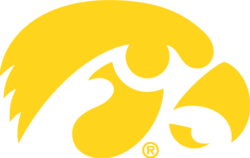Sept. 6, 2004
EDITOR’S NOTE: Every day through the football season, hawkeyesports.com will bring readers a Kinnick Stadium factoid compiled for the 75th Anniversary of Kinnick Stadium.
FACT SIX: The Iowa field hockey team played its home games inside Kinnick Stadium from 1981-1988 when artificial turf was in place. The field hockey team moved into their current facility, Grant Field, in 1989.
FACT FIVE: Hall of Fame coach Hayden Fry introduced “the swarm” upon his arrival at Iowa in 1979. When entering Kinnick Stadium, players jog slowly onto the field, hands locked and with the captains in front. On why he had his players enter the stadium this way, Fry said, “Let’s save it for the game.” The “swarm” is still used today.
FACT FOUR: Ten athletes who called Kinnick Stadium their home have won national awards.
Cal Jones, Alex Karras and Robert Gallery won the Outland Trophy, Nile Kinnick and Chuck Long the Maxwell Award, Long and Brad Banks won the Davey O’Brien Award, Banks also won the AP Player of the Year Award, Nate Kaeding was awarded the Lou Groza Award, and Dallas Clark won the John Mackey Award.
FACT THREE: While Nile Kinnick is the only Iowa player to have won the Heisman Trophy, four Heisman Trophy runners-up have played for the Hawkeyes inside Kinnick Stadium. Alex Karras finished second in the voting in 1957, Randy Duncan in 1958, Chuck Long in 1985 and Brad Banks in 2002.
FACT TWO: Only two Iowa players that have played inside Kinnick Stadium have had their jersey number retired.
Halfback Nile Kinnick, who wore No. 24, won numerous awards in 1939 including the Heisman Trophy. Cal Jones, a lineman from 1953-1955, donned No. 62. He was awarded the Outland Trophy in 1955 and was a two-time consensus all-American.
From Steubenville, OH, Jones earned the praise of Head Coach Forest Evashevski who said Jones was “the greatest lineman I ever coached.” Kinnick’s accomplishments are outlined below.
By surprising coincidence, both Kinnick and Jones had their lives cut tragically short by airplane crashes.
FACT ONE: Finished on Oct. 5, 1929, Iowa Stadium was the completion of a six-month, $497,151.42 project. But in 1972, Iowa Stadium was rechristened Kinnick Stadium in honor of Iowa’s 1939 Heisman Trophy winner Nile Kinnick. But the name of the stadium is perhaps one of the most under-appreciated elements of the 75-year-old edifice.
“I love the fact that we play in Kinnick Stadium,” Iowa coach Kirk Ferentz said recently. “It’s an awesome venue – the stadium itself, and to play in a stadium named after such a legendary individual. To me, there’s some added significance to that and something we all take for granted too often.”
|
“It’s an awesome venue – the stadium itself, and to play in a stadium named after such a legendary individual. To me, there’s some added significance to that and something we all take for granted too often.”
Head Coach Kirk Ferentz
|
Nile Kinnick, who played halfback, was the nation’s top player in 1939, winning the Heisman, Walter Camp and Maxwell Trophies. He was on virtually every all-America team and was the Big Ten’s MVP.
Off the field, Kinnick was senior class president, a member of Phi Beta Kappa and graduated with a 3.4 GPA from the College of Commerce.
Kinnick was going to be a member of the Iowa Law School when World War II broke out and he served as an ensign in the US Navy. And just four years after he led the historic Ironmen team of 1939 to a 6-1-1 record, Kinnick died when the plane he was piloting crashed in the Caribbean Sea in a training mission.
Barry Pump, hawkeyesports.com

%20--%3e%3csvg%20xmlns:inkpad='http://taptrix.com/inkpad/svg_extensions'%20height='231pt'%20xmlns:xlink='http://www.w3.org/1999/xlink'%20xmlns='http://www.w3.org/2000/svg'%20width='796pt'%20version='1.1'%20viewBox='0,0,796,231'%3e%3cdefs/%3e%3cg%20id='Untitled'%20inkpad:layerName='Untitled'%3e%3cpath%20d='M102.252+48.3067L83.5399+48.3067L83.5399+182.202L102.252+182.202L102.252+230.822L-0.0490809+230.822L-0.0490809+182.202L18.6626+182.202L18.6626+48.3067L-0.0490809+48.3067L-0.0490809+0.300613L102.252+0.300613L102.252+48.3067ZM239.828+230.822L165.748+230.822C138.908+230.822+121.27+213.184+121.27+184.35L121.27+46.773C121.27+18.092+139.215+0.300602+165.748+0.300602L239.828+0.300602C266.669+0.300602+284.307+18.2454+284.307+46.773L284.307+184.35C284.307+213.031+266.362+230.822+239.828+230.822ZM218.816+182.356L218.816+48.4601L186.607+48.4601L186.607+182.356L218.816+182.356ZM313.448+48.3067L297.037+48.3067L297.037+0.300613L394.123+0.300613L394.123+48.6135L375.718+48.6135L392.282+159.503L426.945+0.300613L476.025+0.300613L512.834+159.503L526.178+48.6135L509.307+48.6135L509.307+0.300613L605.166+0.300613L605.166+48.6135L589.368+48.6135L560.534+231.129L482.313+231.129L451.945+95.0859L420.963+230.822L345.81+230.822L313.448+48.3067ZM588.141+182.356L605.779+182.356L640.902+0.300613L745.656+0.300613L780.166+182.356L796.577+182.356L796.577+230.975L718.356+230.975L710.994+174.687L672.19+174.687L665.288+230.975L588.601+230.975L588.141+182.356L588.141+182.356ZM706.853+132.509L691.975+39.4111L676.638+132.509L706.853+132.509Z'%20opacity='1'%20fill='%23ffcd00'/%3e%3c/g%3e%3c/svg%3e)